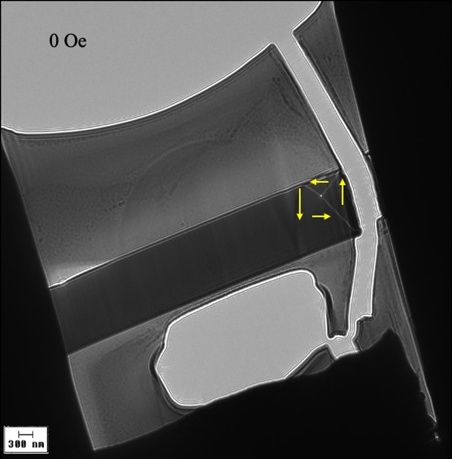Speaker
Description
Rapidly solidified amorphous submicronic glass-coated wires with diameters between 100 and 950 nm, featuring either high or nearly zero magnetostriction, present a bistable magnetic behavior [1], which relies on the propagation of a single magnetic domain wall at velocities that differ considerably in wires with high magnetostriction as compared to those with nearly zero magnetostriction.
Here, we report on the Lorentz microscopy investigation of magnetic domain walls in rapidly solidified submicronic Fe$_{77.5}$Si$_{7.5}$B$_{15}$ and (Co$_{0.94}$Fe$_{0.06}$)$_{72.5}$Si$_{12.5}$B$_{15}$ amorphous wires with high and nearly zero magnetostriction, respectively. Imaging has been performed using a Libra 200 MC Carl Zeiss ultra-high-resolution microscope in Fresnel configuration. Domain wall structures have been observed under an applied field with various amplitudes and directions. Lorentz microscopy data has been associated with hysteresis loop and domain wall velocity measurements for a comprehensive investigation.
Figure 1 shows a domain wall image observed in a nearly zero magnetostrictive sample having 900 nm in diameter, in the absence of an applied field. The domain wall structure does not change with different values of the applied field. Moreover, tilting a field of 900 Oe at small angles with respect to the direction perpendicular to the lamella, does not alter the vortex structure.

Fig. 1 Lorentz microscopy image of a domain wall in a (Co$_{0.94}$Fe$_{0.06}$)$_{72.5}$Si$_{12.5}$B$_{15}$ submicronic amorphous wire with 900 nm in diameter, with no applied magnetic field.
In case of an Fe$_{77.5}$Si$_{7.5}$B$_{15}$ amorphous submicronic wire with high magnetostriction, having the same diameter (900 nm), the vortex domain wall displays an elongation that increases with the value of the applied field. Tilting the field at small angles has the same effect.
The differences in hysteresis loop parameters and in domain wall velocities displayed by the two types of submicronic amorphous wires can be linked to the differences in their domain wall structures. The results are essential towards fully understanding the magnetic behavior of nearly zero and highly magnetostrictive submicronic amorphous samples.
Acknowledgements
Financial support from the MCID Nucleu Program (PN 23 11 01 01 - contract 18N/2023) is highly acknowledged.
References
[1] S. Corodeanu, C. Hlenschi, C. Rotărescu, H. Chiriac, N. Lupu, and T.-A. Óvári, “Structural relaxation in metastable magnetic submicronic wires,” Journal of Alloys and Compounds, vol. 905, 164260, June 2022. doi: 10.1016/ j.jallcom.2022.164260.

